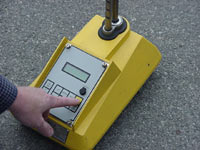-
Nuclear Meter Surveys use a nuclear density gauge and must be performed by
Certified Nuclear Gauge Operator. The equipment uses low level
radioisotopes to detect hydrogen atoms present within the system and
produce a numerical readout directly proportional to the number of hydrogen
atoms present. The nuclear meter emits a stream of high velocity neutrons
that collide with hydrogen atoms and give up some energy and then rebound to
the metering device at a slower speed.
-
Since each molecule of water is made of two hydrogen and one oxygen atoms,
the meter then records these slower speed neutrons and provides a digital
reading on a pre-set calibrated scale. Readings generally take from seven
to sixty seconds each and are done in a grid pattern that varies from three
feet to ten feet on center. High readings may also be obtained at any
point where more hydrogen atoms are present such as changes in material
thickness or other variations in system density.
-
Surfaces to be surveyed are evaluated utilizing a grid system, generally on 10
foot intervals. Readings are taken at each grid point on the surface and
recorded on a scaled map.
-
Once all readings have been completed, a destructive test is taken and used to
correlate the recorded readings to moisture content. If moisture presence
is confirmed, the perimeter of the area is then outlined on the surface,
usually with spray paint. Areas found to contain wet materials are then
recorded on a scaled drawing scaled map along with the location of all invasive
test sites. The testing equipment should be calibrated at each jobsite as
well as for different assemblies and thicknesses within a single site for
accurate results.
|
